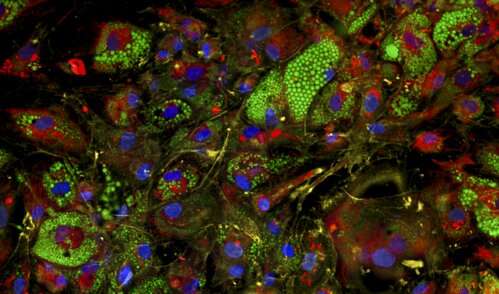This article has been reviewed according to Science X's editorial process and policies. Editors have highlighted the following attributes while ensuring the content's credibility:
fact-checked
peer-reviewed publication
trusted source
proofread
New image-based cellular profiling tool peers deeply into metabolic biology

The field of microscopy has advanced immensely over the last fifty years in its ability to extract both quantitative and qualitative data from microscopy images. In a paper published in Cell Genomics, researchers at the Broad Institute, Harvard Medical School, Massachusetts General Hospital, Technical School of Munich (TUM), and the University of Oxford have presented LipocyteProfiler, a new, high-throughput quantitative bioimaging tool to help bridge the gap between morphological observation and functional profiling.
LipocyteProfiler is a powerful imaging technique that generates comprehensive microscopy-based profiles of cells using multiple fluorescent dyes chosen specifically for studies of cardiometabolic biology. Image analysis software captures information about more than 3,000 cellular features, providing a deep view into the impacts of genetic variants, small molecule or genetic perturbations, and more on cellular shape, structure, and function.
"It moves the community from a very targeted, hypothesis-driven, unidimensional cell-based assay framework to one that allows us to survey biological processes in a cell and assign function to genes and genetic variations in an unbiased manner," said Melina Claussnitzer, who is a Broad institute member, associate director of the institute's Novo Nordisk Foundation Center for Genomic Mechanisms of Disease, faculty of the Center for Genomic Medicine at Mass General, and the senior researcher of the study.
Common genetic variants associated with cardiometabolic disease can produce phenotype changes of such small effect that they can be difficult to characterize. The current proof-of-concept study showcases how the use of a set of dyes chosen with a disease or trait in mind can illuminate cellular and subcellular behaviors at unprecedented depth and scale.
LipocyteProfiler builds on the concept of image-based profiling that was first introduced in the context of morphology mapping by Cell Painting, a high-content imaging assay developed by Broad institute scientist and Imaging Platform senior director Anne Carpenter.
Whereas Cell Painting labels eight general organelles or components of the cell, LipocyteProfiler uses six fluorescent dyes that together illuminate the morphology and activity of nine cellular compartments: the nucleus, nucleoli, mitochondria, endoplasmic reticulum (ER), Golgi apparatus, cytoplasmic RNA, f-actin cytoskeleton, and plasma membrane, and lipid droplets (fat-storing organelles that regulate lipids within every type of cell and which are particularly common in adipocytes). It then extracts features from images of stained cells and creates cellular profiles, categorizing cells based on patterns (often imperceptible to the human eye) that they share with other cells, which directly inform disease biology.
To assess LipocyteProfiler, the researchers analyzed white and brown fat cells and liver cells, focusing on traits such as the size, the number, and the location of lipid droplets in a cell. When comparing cells with a particular genetic variant to those without, the team found that the LipocyteProfiler protocol detects morphological and mechanistic differences between the cells, allowing for linkage of genetic variation to phenotypic traits. LipocyteProfiler also highlighted discrete cellular mechanisms and pathways when used to analyze metabolic traits associated with high polygenic risk scores.
"We could identify and examine more than 700 features just related to lipid accumulation," said Sophie Strobel, a lead author on the paper who is now at TUM. "That teaches us far more than looking for just a single informative data point."
The researchers also looked at the tool's ability to detect changes in cellular phenotypes after exposure to drugs and small molecule compounds. Typically, studying drug therapies is an expensive and time-consuming undertaking. With high-resolution, cell-based profiling techniques, extracting a large amount of data can be done cheaply and efficiently.
"I think drug screens are an obvious next step for using the platform because image-based screens tend to be pretty inexpensive, and they can be scaled up so that you can assess and evaluate hundreds of thousands of compounds and see which ones impact the phenotypes that are associated with disease," said Cell Painting creator Carpenter, who collaborated on the LipocyteProfiler project.
LipocyteProfiler is already being used experimentally to look at relationships between genetic variants and their functions. Claussnitzer and the University of Chicago's Marcelo Nobrega recently used LipocyteProfiler to reveal a mechanism connecting the gene COBLL1 and a diabetes-related metabolic phenotype called metabolically obese normal weight. By using the tool, Clausnnitzer and others saw how a variant that reduces COBLL1 expression interferes with lipid droplets' growth within a cell.
Claussnitzer's lab is now working to expand the machine-learning aspect of LipocyteProfiler, with an eye toward tracking information flow within single cells from transcription to phenotypes. Experimentally, the lab continues to use LipocyteProfiler to assess the relationships between genetic variants and cellular programs, to understand highly granular processes of disease biology.
Claussnitzer notes that LipocyteProfiler is a powerful addition to the -omics tool box, one that looks beyond epigenomics, transcriptomics, and proteomics to allow systematic, unbiased, image-based profiling of cellular phenotypes. And while the technology is the first to adapt the Cell Painting protocol, researchers at the Broad and beyond are already working to create assays like LipocyteProfiler for their own respective fields.
"Just as we applied stains related to lipid biology and metabolism," Strobel said, "one could instead swap in stains for something related to, say, lymphocyte biology, depending on the question you want to answer and what disease you are looking at."
Carpenter notes that she is satisfied seeing people expand on her work on Cell Painting, saying "in the end, none of the work matters if biologists aren't adapting it in their labs for the myriad of disease areas that people work on."
More information: Samantha Laber et al, Discovering cellular programs of intrinsic and extrinsic drivers of metabolic traits using LipocyteProfiler, Cell Genomics (2023). DOI: 10.1016/j.xgen.2023.100346
Journal information: Cell Genomics
Provided by Broad Institute of MIT and Harvard





















